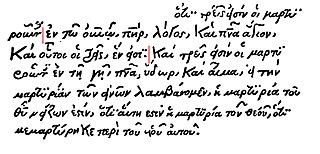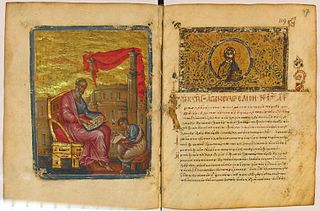Related Research Articles

Minuscule 5, δ 453, is a Greek minuscule manuscript of the New Testament, on 342 parchment leaves. Using the study of comparative writing styles (palaeography), it has been dated to the 13th century.

Codex Montfortianus designated by 61, and known as Minuscule 61 is a Greek minuscule manuscript of the New Testament on paper. Erasmus named it Codex Britannicus. Its completion is dated on the basis of its textual affinities to no earlier than the second decade of the 16th century, though a 15th-century date is possible on palaeographic grounds. The manuscript is famous for including a unique version of the Comma Johanneum. It has marginalia.
Minuscule 639. It is a Greek minuscule manuscript of the New Testament, on a parchment. It is dated palaeographically to the 11th century. The manuscript is lacunose. Formerly it was labeled by 192a and 246p.

Minuscule 1424, δ 30 is a Greek minuscule manuscript of the New Testament, written on 337 parchment leaves. It has been dated paleographically to the 9th or 10th century).
Codex Regis, is a Greek minuscule manuscript of the New Testament, on parchment leaves. Palaeographically it has been assigned to the 12th-century. It has marginalia.
Minuscule 94 (in the Gregory-Aland numbering), O31 (von Soden), is a Greek minuscule manuscript of the New Testament, on parchment and paper, dated to the 12th or 13th century. Formerly it was labelled by 18a, 21p, and 19r.
Minuscule 175, δ 95 (Soden), is a Greek minuscule manuscript of the New Testament, on parchment. Palaeographically it has been assigned to the 12th century. It has marginalia.
Minuscule 206, α 365 (Soden), is a Greek minuscule manuscript of the New Testament, partly on parchment, partly on paper. Palaeographically it has been assigned to the 15th century.
Minuscule 263, δ 372 (Soden), is a Greek minuscule manuscript of the New Testament, on parchment. Paleographically it has been assigned to the 13th century. It has marginalia.

Minuscule 330, δ 259 (Soden), is a Greek minuscule manuscript of the New Testament, on parchment. Palaeographically it has been assigned to the 12th century. It has marginalia. The Greek text of the codex is a representative of the Byzantine text-type.
Minuscule 365, δ 367 (Soden), is a Greek minuscule manuscript of the New Testament with some parts of the Old Testament, on parchment. Paleographically it has been assigned to the 12th century. It has marginalia.
Minuscule 424, Ο12, is a Greek minuscule manuscript of the New Testament, on parchment. Palaeographically it has been assigned to the 11th century. Formerly it was designated by 66a and 67p.
Minuscule 431, δ 268, is a Greek minuscule manuscript of the New Testament, on parchment. Palaeographically it has been assigned to the 12th century. It has marginalia. It is known as Codex Molsheimensis.
Minuscule 436, α 172, is a Greek minuscule manuscript of the New Testament, on parchment. Palaeographically it has been assigned to the 11th or 12th century. Formerly it was labelled by 73a and 80p.

Minuscule 456, α 52, is a Greek minuscule manuscript of the New Testament, on parchment. Palaeographically it has been assigned to the 10th century. Formerly it was labelled by 86a, 96p, and 75r. Marginalia are incomplete. The manuscript was prepared for liturgical use.

Minuscule 459, α 104, is a Greek minuscule manuscript of the New Testament, on parchment. It is dated by a colophon to the year 1092. Formerly it was labeled by 89a and 99p.
Minuscule 467, α 502, is a Greek minuscule manuscript of the New Testament, on paper. Palaeographically it has been assigned to the 15th century. The manuscript has complex contents. Formerly it was labelled by 116a, 136p, and 53r.
Minuscule 522, ε 145, is a Greek minuscule manuscript of the New Testament, on a paper. It is dated by a colophon to the year 1515 or 1516. Scrivener labelled it by number 488. It was adapted for liturgical use.
Minuscule 620, α 207, is a Greek–Latin diglot minuscule manuscript of the New Testament, on parchment. Palaeographically it has been assigned to the 12th century. The manuscript is lacunose. Tischendorf labeled it by 149a, 349p, and 180r.
Minuscule 638, α 188, is a Greek minuscule manuscript of the New Testament, on parchment. Palaeographically to the 11th century. The manuscript is lacunose. Scrivener labelled it by 191a and 245p.
References
- 1 2 3 4 K. Aland, M. Welte, B. Köster, K. Junack, "Kurzgefasste Liste der griechischen Handschriften des Neues Testaments", Walter de Gruyter , Berlin, New York 1994, p. 182.
- ↑ Bruce M. Metzger, Bart D. Ehrman, "The Text of the New Testament: Its Transmission, Corruption and Restoration", Oxford University Press (New York - Oxford, 2005), p. 92.
- ↑ Aland, Kurt; Aland, Barbara (1995). The Text of the New Testament: An Introduction to the Critical Editions and to the Theory and Practice of Modern Textual Criticism. Erroll F. Rhodes (trans.). Grand Rapids: William B. Eerdmans Publishing Company. p. 137. ISBN 978-0-8028-4098-1.
- ↑ κυριε